At age 63, Tom, a retired clerical worker, wasn’t planning to live out his golden years in the back seat of an old beater car in Arizona’s Sonoran Desert.
Living alone on a fixed income, Tom said he was just getting by on Social Security until the housing prices in Phoenix began to climb in 2021.
He knew he couldn’t afford the higher amounts in monthly rent on his meager income. So he decided to go out on his own, and become a “boon-docker,” slang for someone who lives off-grid.
In October, Tom packed all his belongings into his ancient white 1984 Lincoln sedan along with his two cats. Then, he drove 127 miles south, to Quartzsite, Arizona, a nationwide destination for recreational vehicles.
Once he got there he staked out a small patch of dirt on long-term visitor land operated by the U.S. Bureau of Land Management and marked the boundary line with pebbles.
He’s been calling it home ever since.
“I couldn’t find a place to live. It’s the whole state now. I’m okay with it. I’m able bodied–you save a lot of money” on rent, he told The Epoch Times.

Tom, who asked that his last name not be used, is part of a growing demographic of road nomads, who have chosen or been forced to live full time in a four-wheeled vehicle on public land.
It can be a tense co-existence at times, officials say, as longterm boon-dockers compete with traditional RV campers looking to enjoy the great outdoors. In recent years there have been reports of property crime, piles of trash, and other social problems associated with non-recreational camping.
In March 2021, the U.S. Department of Housing and Urban Development released its 2020 Annual Homeless Assessment Report, which found that 580,466 people experienced homelessness in the United States on a single night in 2020, an increase of 2.2 percent from 2019. This included sheltered and unsheltered chronic homeless people, most notably veterans and minorities.
HUD Secretary Marcia Fudge called the findings “troubling,” believing that housing should “be a right, not a privilege.”
The report also found the rise in unsheltered homelessness was driven largely by increases in California, a Democrat-run state known for its high cost of living.
At the La Posa South Long-Term Visitor Area in Quartzsite, where Tom has set down roots for the time being, volunteer host coordinator Sue Parker said it’s easy to tell a long-term visitor from a regular camper.
The long-term visitor has been issued a yellow sticker to place on their windshield, she said.
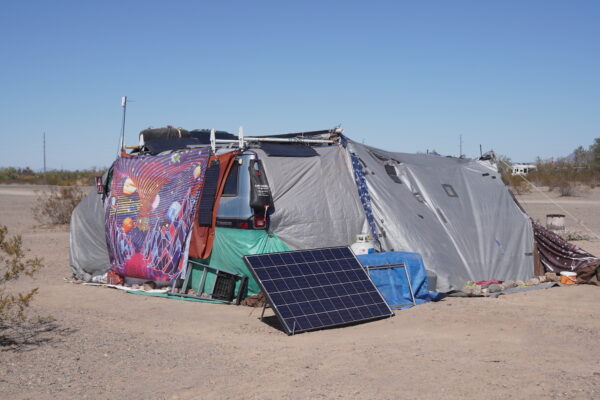
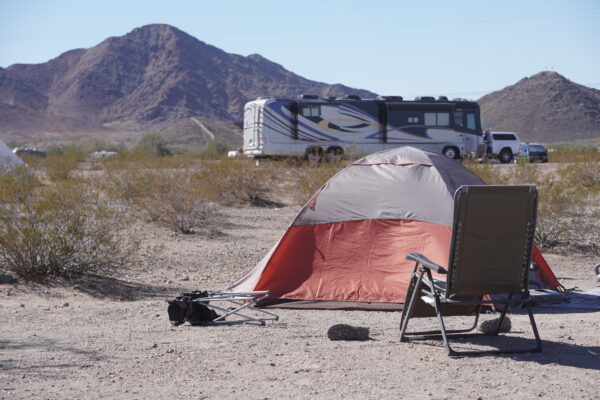
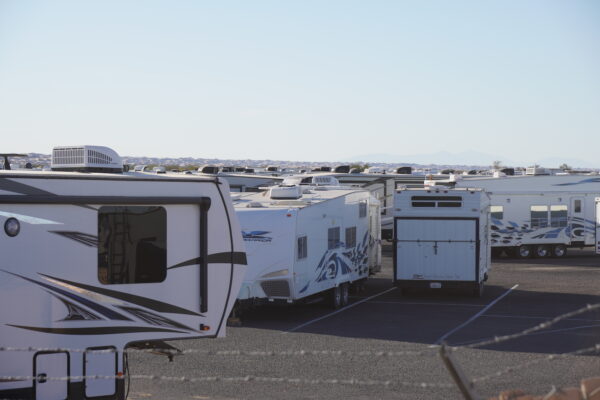
The fee for a long-term permit is $180 for a seven-month seasonal stay between September and April. Amenities include bathrooms with running water and a place to dump refuse. The BLM’s Yuma Field Office manages the La Posa site.
Parker said at last count, there were 300 long-term visitor permits issued in La Posa in 2022. “A lot of them” have been for people arriving from California, she said.
“We’ve had people from Australia and Japan. They have their computers, so there’s internet here,” she told The Epoch Times.
When long-term visitors get sick, “we call an ambulance.” When there’s trouble, “we call police,” Parker added.
Tom said COVID-19 was not a factor in his decision to go off-grid. Instead, he needed a place—any place—within driving distance of his elderly mother, who is 89.
“My life is right here in this car,” said Tom as he rummaged through the car trunk where he keeps his tools and other essential possessions.
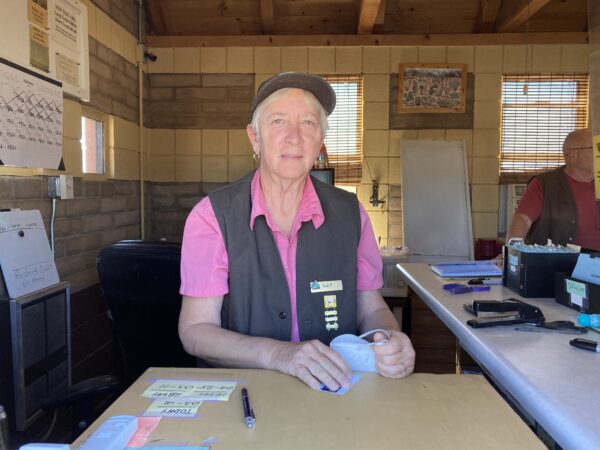
Parked around him was a motley assortment of camper vans, tents, and recreational vehicles, all with yellow stickers, in various stages of decay.
The thing Tom said he likes most about boon-docking is the freedom and privacy of wide-open spaces, the warm desert winters, and spectacular mountain views.
“I have a fan,” he said when asked about the hot weather. “When it gets real hot, I go somewhere else. My best neighbors are right here in this ant hole. I don’t bother them. They don’t bother me. No drama.”
Scorpions, however, don’t make very good neighbors. He suspects a scorpion bite killed one of his two beloved cats.
He drapes the car windows and doors with sunshades to stay cool. He uses a propane stove for cooking.
“It’s not horrible,” Tom said of off-grid living. “A little lonely, I suppose. Sometimes.”
About 130 miles west of Quartzsite lies the rural agricultural town of Niland, California. Next to it, Slab City, an old World War II military base settled years ago by nomads and artists seeking freedom from the burgeoning human cost of urban living.
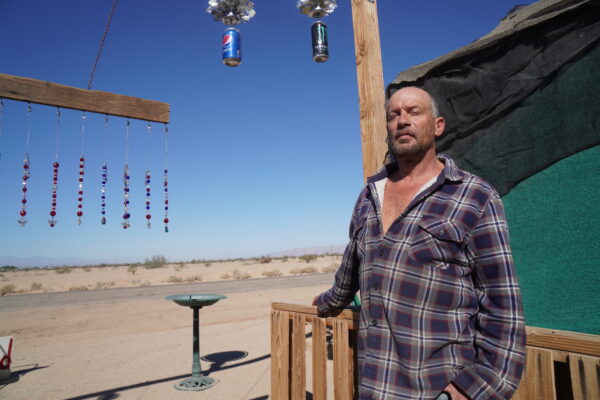
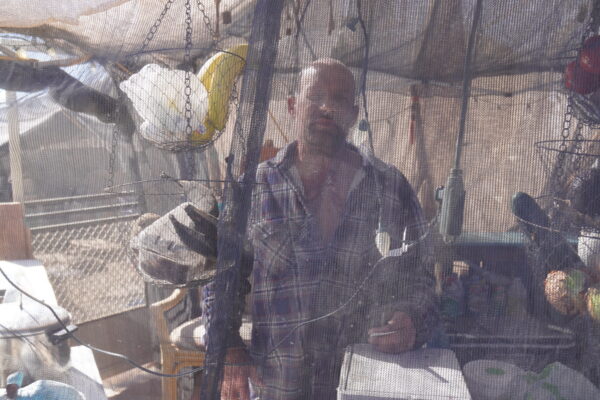
Slab City, however, has no official owner, residents say. The “city” got its name from the slabs of concrete left behind by the military and on which many decrepit campers now reside.
The eclectic community is often viewed as a work in progress. It boasts having an Internet cafe, library, free coffee shop, and a thriving artistic community in a place called “East Jesus.” There’s even a volunteer “Slab Cab” taxi service for a nominal fee.
For the religious-minded, Salvation Mountain, with its towering white cross and painted biblical verses, proclaims “God Is Love.” Every year, thousands of visitors arrive eager to ponder its spiritual messages.
“Hey, mom, I forgot. What’s a sinner?” asked a boy, about eight years old.



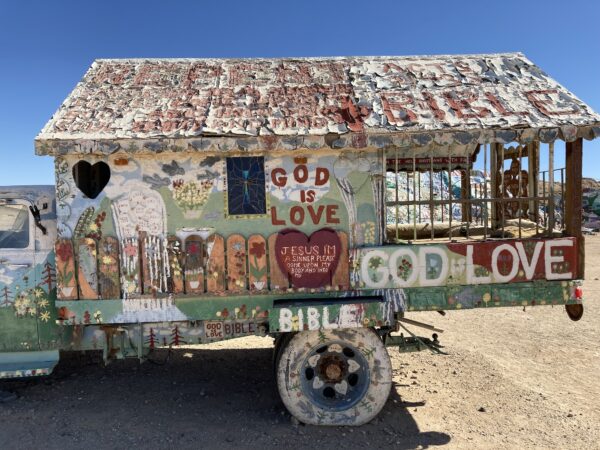
Jimmy James, 53, an artist and musician from Wisconsin, said he’d been a Slab City dweller since the day his converted school bus broke down here almost four years ago.
Now, he owns and operates an arts and gifts store, lives in a trailer, and hopes someday to sell the business and buy a new school bus and hit the road once again.
As “the last free place” in America, Slab City living isn’t free, though, James said. It costs him $50 a day to live comfortably on average.
“You have to have some kind of income unless you want to live off of scraps,” he told The Epoch Times. “You’re free to be an artist. Nobody is going to tell you what to do.”
But even the “free stuff” from local charities comes at a price.
“The free stuff that comes out here demeans you after a while. I think it’s better to earn your money,” James said.
A single mother from San Diego, Vida makes her living doing tarot card readings and massage therapy out of a trailer. Though, at one point, she had “an amazing job” in Los Angeles that left her feeling stressed out and drained.
“I was working so much, doing this, doing that for (the) church. I was in online school, and I was just about to have a mental breakdown,” she said. “It was like, too much. Nothing was feeding my soul. I was working six days a week. I was all about money. I had a nice studio apartment—everything.”
“Enough was enough,” she told The Epoch Times. “I didn’t want to be a slave any more. So I came here without knowing anything about it. When I came here, it was open arms. I was welcomed.”
Of the current estimated 500 long-time Slab City residents, everyone has a different story to tell, she said.
Some came here searching for something, others to leave something behind.
“I tried to go back to the city life. After experiencing that, I came back. I didn’t want to be a slave again. I’m here to home school (her toddler son) and go off-grid. The freedom. You can be who you want,” Vida said.
However, when it comes to hard times, people always seem to pull together as a community, said Vida. And while random acts of kindness are common, “not everybody is a freeloader. There’s people that have regular jobs they go to. People come here to retire.”

It’s not like home, “it is home.” The tourists, she said, are another story.
The inconsiderate ones leave their trash behind, or they’ll take unwelcome pictures.
Or, they’ll “fly by” in expensive cars, trucks, and SUVs and put people in danger, Vida said.
“Most people have just had it” with urban life, observed Jon, a Niland resident, who makes frequent visits to Slab City to help people in need. He described the relationship between Slab City and Niland as generally good.
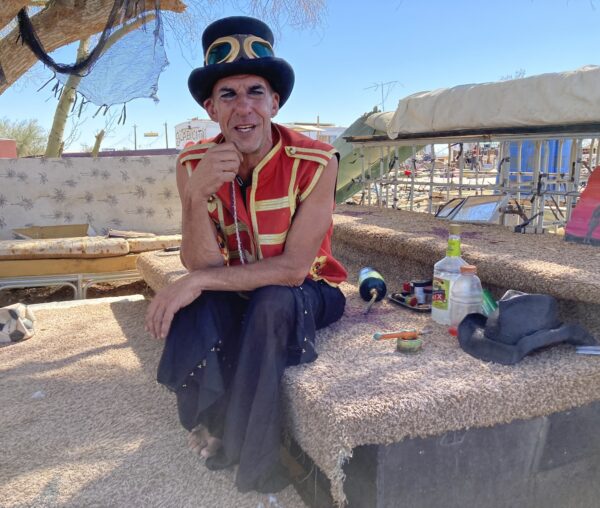
“People in town and people here just kind of get along. They come into town to go grocery shopping or get their mail. It’s self-governing, so to speak,” he told The Epoch Times. “I think (people) are starting to come out more. But they have to have the sense that it’s going to hit 120 degrees in the summertime.”
Adobe artist Peter Passalacqua, 51, dressed in a black top hat, bright orange and gold-embroidered vest and loose fitting pants, said he moved to Slab City from Portland, Oregon three years ago to become a better artist.
“We have people on Social Security who can’t afford to live in suburbia,” he said. “In Slab City, you can live on $1,000 a month. My goal is $20 a day. There really is nothing hard about living in Slab City. You have to have your own water. You have to feed yourself. A lot of (older) people come here to die.”
“You don’t choose to come to Slab City,” Passalacqua said. “Slab City chooses you.”
While living off-grid often is associated with urban areas, since the Great Depression national forests and grasslands have also served as a refuge for itinerant people, according to the U.S. Department of Agriculture Forestry Service.
“In recent years, more people are living on the national forests and grasslands, whether by choice or because of economic circumstances. Unfortunately, the presence of non-recreational campers affects the experience of other users and results in increased levels of trash and resource degradation that can be costly to remediate,” the agency said.
In 2015, Lee Cerveny, a social scientist with the Forest Service’s Pacific Northwest Research Station, and Joshua Baur, a professor at San Jose State University, surveyed law enforcement officers nationwide to determine how often they encountered non-recreational campers and the effects of their lifestyle on the natural and social environment.
The study found transient retirees formed the largest group of non-recreational campers, followed by displaced families, and homeless people.
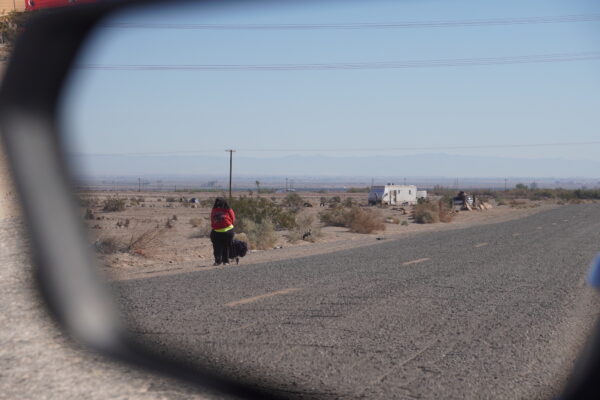
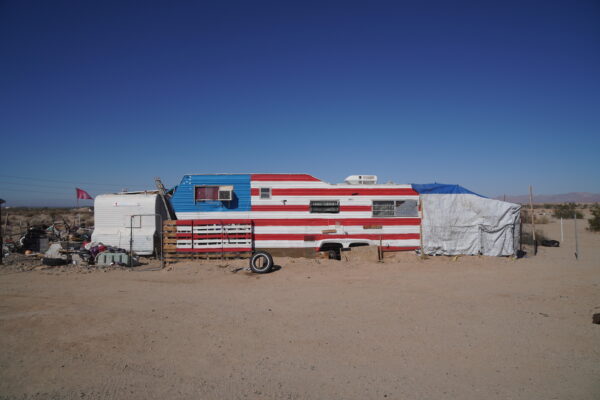
“Economic instability was perceived to be a contributing factor for residing on the national forest, followed by drug and alcohol abuse, and mental health concerns,” the study found.
The Willamette National Forest in Oregon, in the meantime, is using information from the study to better equip frontline employees when dealing with non-recreational campers including how to address the health challenges of living outdoors.
“It would be interesting to probe a bit about where the ‘choice’ is in their decision-making. Many folks in this community have few choices. They are pushed to the edges financially and if they did not live in this way, they might be living in a shelter,” Cerveny said. “They also may face mental health challenges (anxiety) or trauma that make sedentary habitation challenging.”
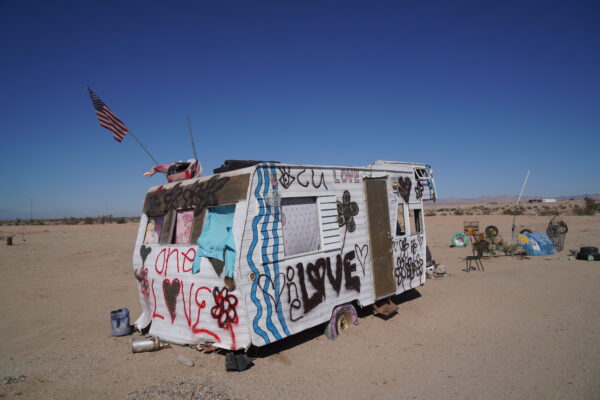
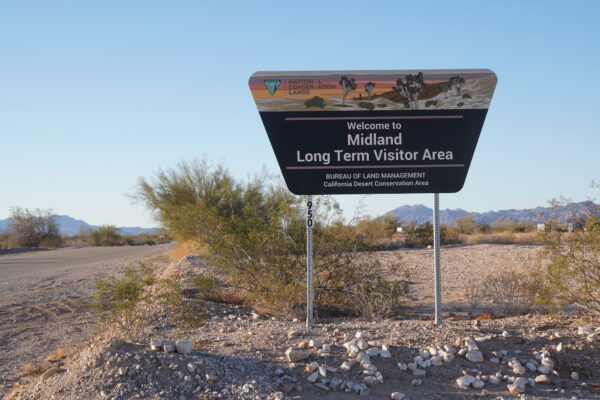

Cerveny said the freedom to move and keep moving may be critical for some, though for others with anxiety, “perpetual movement and freedom from entrapments may be therapeutic.”
Since the study was released, Cerveny has been getting calls from public land managers in many states asking about new information, “which suggests that I might want to repeat the 2015 study,” she said.
At RV Lifestyles in Quartzsite, sales department employee Susie Taylor said the number of people living and working out of their recreational vehicles has been on the rise since the pandemic.
“What I’ve noticed coming not only from an RV sales point of view but a repair point of view is that there’s more people traveling as more people weren’t able to go back to work,” Taylor told The Epoch Times.
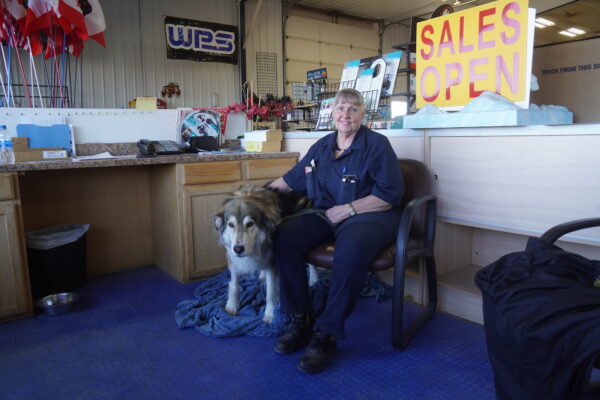
“They were forced to work from home. They realized if they were able to find a way to be mobile they would work from their mobile unit instead of staying at home, in the snow, and they could travel where there was sunshine. We see an influx of people that way, and the age is much younger than the normal retired people we would see from years past.”
Taylor said that living in an RV gives people “the best of both worlds. They can be in weather that they like.”
“I’ve been on the road full-time almost 30 years myself, doing RV repair nearly 25 of those years, and then working in an RV dealership such as this since my husband passed,” she said. “It’s giving them the best of both worlds, raising their kids on the road, doing homeschool and all that.”
Since much of the remote work is done on a computer, she said, the nomadic lifestyle is even more appealing–and feasible.
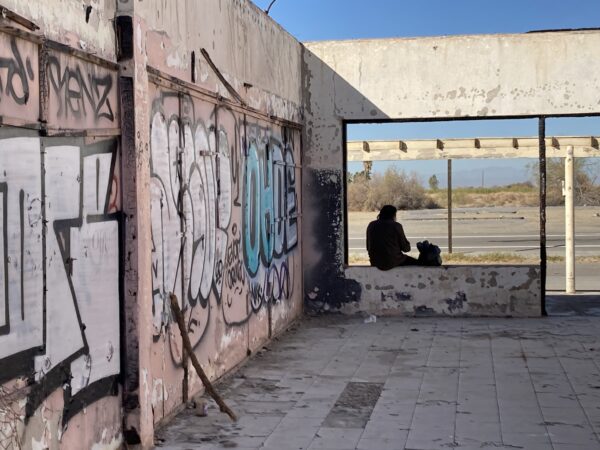
Many people new to boon-docking have been at it for a couple of years, she said.
“They’re still in the excitement the honeymoon of it all. I do like the lifestyle, but my dream is to be a snowbird. They look at me funny. I’d like to have a home base somewhere again, because I’m getting older. When you’ve been doing it for a long time some of it does wear on you. You’re moving all the time.”
Taylor said the demand for RVs has been growing since the pandemic, and some models are hard to find.
According to the RV Industry Association, the latest sales forecast for year-end 2021 was between 594,000 and 611,000 units, a nearly 40 percent gain over 430,412 units shipped in 2020 during the pandemic. Continued growth is expected through 2022 with shipments expected to surpass 600,000 units.
“People owned an RV that they used to travel in for vacations not being able to keep their home any more (meant) they had to make a choice, so they would sell the home and keep the RV and do that lifestyle,” Taylor said.
“It’s the cheapest way to live. They can live here in Quartzsite. They can live on the BLM land for seven months for the cost of $180 total. And they provide sewer, dump, water, fillip and trash dump. They call it boon-docking, where they’re not plugged in. They’re kind of off-grid if you will. And a lot of them have solar, they live off-grid and they feel really free that way.”

“Pretty much anybody who buys (an RV) any more say that’s their plan. The sad part is they go into it uneducated. If you do it wrong, it can cost a lot of money. Most people are just trying for a simple life–more freedom. If they’re out for the glamorous life, I don’t think they’ll stay with it long,” Taylor said.
Tom, at La Posa Long-Term Visitor Area, said his dream is to find a home that suits him at a price he can afford.
But even that seemed like a pipe dream as he sat basking in a fold-out chair in the shade of his open car trunk in 80-degree weather.
“If I can find a place (fine), but I’ve pretty much given up,” he said.


